Abstract
The Fowan Cliff Carvings are a key part of the Dazu Grottoes. Formed in a southern and northern stretch, the 290 individual niches at Fowan were mostly sculpted from the Late Tang to the Southern Song. Previous research by archaeologists and art historians has used typological and iconographic methods to periodize these niches and debate the themes behind particular niche sculptures. This essay employs niche inscriptions in a discussion of typical Fowan niche contents, matching lay feasting activities onto the period background behind their construction. These individual case studies grant an understanding of the overall atmosphere at Fowan through the shared inclinations or connections between niches, also reflecting specific niche sculptures via holistic analysis. This method, repeatedly examining the relationship between the niches and site from the perspective of “venue”, helps us restore a sense of situatedness when facing different eras of Fowan and to understand the choice in statue content, changes in niche content, and the design underlying niche form.
1. Introduction
The Dazu Rock Carvings, in Chongqing, southwest China, are home to more than 70 carved statues, considered classics of the swansong period of Chinese grotto art and included in the site’s listing as a UNESCO World Heritage Site in 1999. The focal point of this essay, the Beishan 北山 (North Mountain) cliff sculptures, are of a larger scale and considered of somewhat higher academic value than other sites, with rather significant clusters at Baodingshan 寶頂山, Nanshan 南山, Shizhuanshan 石篆山, and Shimenshan 石門山 (Figure 1). Despite their final presentation, the history behind the construction and composition methods of each sculpture differed fundamentally in each case. Sculptures at Baodingshan, 15 km northeast of the Dazu District, were first opened in 1179, sponsored by Zhao Zhifeng 趙智鳳, an eminent monk of the times. The Dafowan 大佛灣 Sculptures carved out from a saddle-shaped cliff-face in a valley cul-de-sac, which stand out, especially for their great height and unusual form, were likely the product of Zhao’s holistic planning (J. Li 2016). The Nanshan Sculptures lie at the peak of Nanshan (South Mountain), 2 km to the south of Dazu District. A mere five niches, they belong to a Daoist cluster carved out during the Shaoxing reign period (1131–1162) of the Southern Song. Shizhuanshan’s statuary is spread out over several enormous rockfaces on the outskirts of Fohui Village 佛會村, 20 km southwest of Dazu District. Shizhuanshan was excavated from 1082–1096. Over ten niches each convey different subject material. The most up-to-date research indicates that Shizhuanshan served as a site for Buddhist rites set up in his private estate by the landlord Yan Sun 严逊, deities at each shrine being individually invoked in sutra readings for the deceased (Hou 2013; Wei 2020).
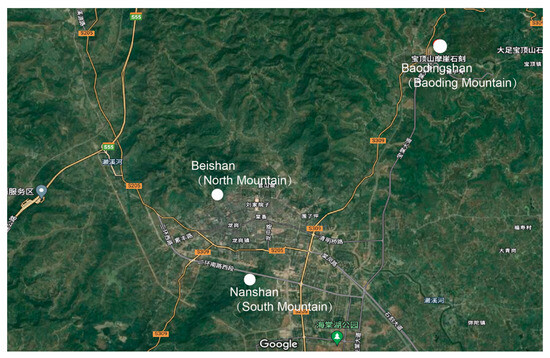
Figure 1.
Distribution of Tang–Song Rock Carvings at Three Major Sites around Dazu City.
The Beishan Fowan Sculptures are the most complex of any case. The full construction project lasted from the Late Tang to the Southern Song. Across these two-and-a-half centuries, Fowan’s donors constructed close to 300 niches spread out over more than 200 m of sheer cliff. Beginning with dated sculptures, scholars have employed a typological methodology to provide a periodization of these sculptures (Li and Wang 1988). Iconographic techniques have determined what materials were used in the vast majority of Fowan’s sculptures and analyzed the Buddhist school of thought behind many different niches. Li Fangyin’s “Collected Carvings of the Dazu Sculptures–Beishan Grottoes” presents the above research in a concentrated manner (F. Li 1999). Li’s essay follows a chronological narrative framework, taking us through the niches constructed in each period, as well as the materials used and salient artistic points. Indeed, Li’s narrative technique helps the reader form an understanding of the overall cluster, though it comes up short on historical reality. To be specific, on the one hand, the reader may receive the mistaken impression that the entire process of excavating the Beishan carvings was no more than a continuous accretion of different sculpture styles at different times. In fact, the primary sponsor or devotee behind any one sculpture had their own understanding and ability to exploit the cliff face. Looked at in a broader light, the cluster when considered overall experienced subtle changes in different period atmospheres—changes that are absent from Li’s narrative. On the other hand, the purpose of such an iconographic framework seems only to organize popular sculpture themes of different periods, overlooking the individual selection of the donor behind a variety of subject matter. Put another way, these donors should not be lumped together as some middle- or lower-level population: Their individual emotions or political expressions, situated within their specific historical backgrounds, merit their own explanation. The “revisiting” intended by this essay involves re-examining the major overall background for this period, the interactions between the Fowan arena and its specific sculptures as a means to establishing a new understanding and means of narrating cliff sculpture.
2. From Military Subspace to Public Sculpture Space
In the late ninth century, with its frontier commands pursuing a separatist line during the final throes of the dynasty, the central Tang government lost any pretense of local control. This was exacerbated by the nationwide Huang Chao 黃巢 Rebellion from 878–884, which placed the Empire on the brink of collapse. It was against this background that Wei Junjing 韋君靖, a warlord of eastern Sichuan, began to accrue power, emerging as Regional Commander 節度使 (jiedushi) of the Jingnan Army 靖南軍 in command of Chang 昌, Pu 普, Yu 渝, and He 合 Prefectures. Dazu itself served as the administrative capital of Chang Prefecture. In 892, aiming to consolidate this separatist stance, Wei elected Longgangshan 龍崗山 (Longgang Mountain) at the northwest corner of the city as the place to construct Yongchang Fort 永昌寨, his pretext being “lack of a fortified city perimeter”. Yongchang was both a military bulwark and a site of refuge for the population from the Prefecture and surrounding area. This Longgang redoubt shadowed the mountains, making it well protected and quite impenetrable, with additional proximity to the city (only 1.5 km from modern Dazu)—all geographical advantages. The military installation featured over 100 watchtowers and 2000 stretches of city wall. Enough grains were in storage to provide for a population of several ten thousand for over a decade (DSML 1999, p. 38). Comparatively speaking, the sculptures at Fowan in Bieshan occupied no more than a subsidiary space within this enormous and comprehensive military operation (Figure 2, Figure 3 and Figure 4).
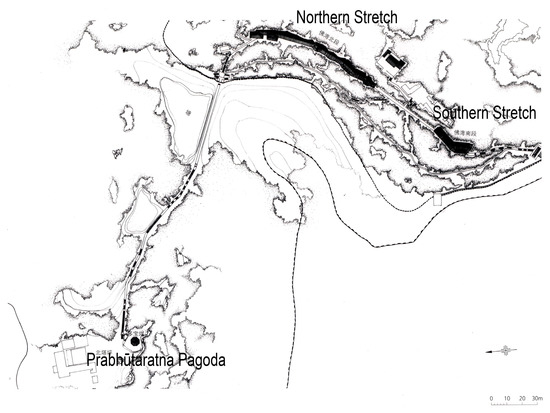
Figure 2.
Plan of Fowan at Beishan.
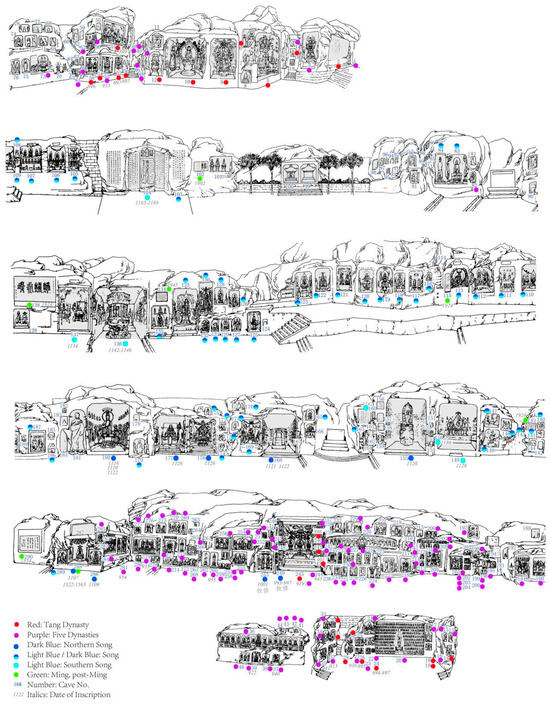
Figure 3.
Continuous Frontal View of the Dazu Beishan Niches and Caves (Drawn by Xiangying Guo, Chronology by Song Li).
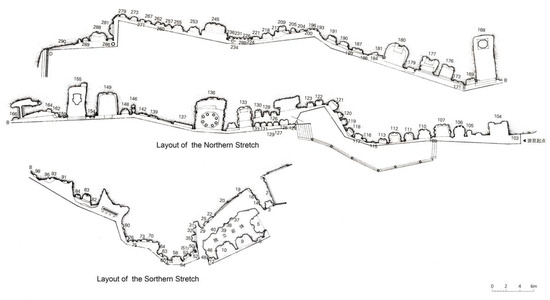
Figure 4.
Layout of the Fowan Niches and Caves, Beishan.
During this period, two groups of public niches were constructed at Fowan in Beishan, providing the initial spark for niche and sculpture carving. (In this article, a niche refers to a cliff-side sculptural space that is inaccessible to people or was not intended for human entry and use. On the other hand, a cave refers to a sculptural space where various ritual activities related to the sculptures can be conducted within its interior.) The first group consists of Niches 2, 5, 9, and 10 in the south of Fowan (Figure 5). Niche 2 bears a lengthy inscription which constitutes the most important document in the early history of Beishan (DSML 1999, pp. 37–43). In its first section, the Wei Junjing Stele describes the deeds of Wei Junjing, the construction of the Longgang Fort, and the content of the sculpture. In its second part, the text enumerates 145 military officers. The contents of the statues mentioned in the inscription correspond to Niche No. 9 for the Thousand-Hand Guanyin and Niche 10 for Sakyamuni Buddha. Niche 5 features a sculpture of the Vaiśravaṇa Heavenly King, a subject which is, however, absent in the Wei Junjing Stele, though previous research has amply demonstrated Vaiśravaṇa’s appearance in a contemporary Sichuan sculpture as a God of War for the military or a local Protector God, suggesting possible connections to the embattled state of Sichuan in Wei’s times (Lei 2011). Combining niche form and sculpture style, we infer that No. 5, 9, and 10 would have been designed wholistically by the leadership of the military fortress and completed around the same period of time. Both the Thousand-Hand Guanyin and Vaiśravaṇa satisfied contemporary calls for salvation or protection under the same fortress.
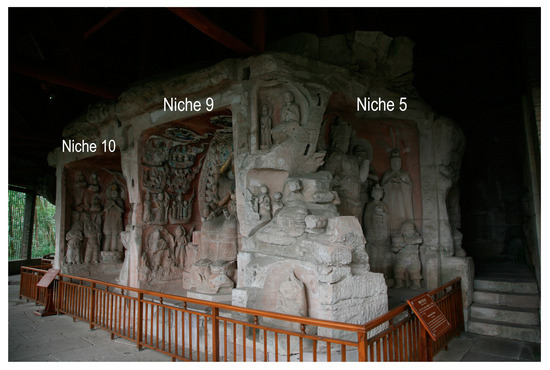
Figure 5.
Niches 5, 9, 10 (Late Tang) (photo taken by author).
The second public niche group centers on the large Late Tang Niche 245 (Figure 6). A total of 4.7 m high and 2.58 m wide, this niche depicts the transformations of the Amitāyurdhyāna Sūtra, one of the most popular Tang Buddhist transformation sutras. The niche is located centrally between Niches 193 and 280 in the north stretch of Fowan. Later niches were carved out on the flanks but at some distance from the central sculpture. Precise dates survive for Niche 240 (896) and Niche 243 (901), situated on the right and closely hewing to Niche 245. Examining their respective placement, the construction of Niche 245 must have preceded the year 896. Four rows of donors line up between Niche 248 and 249, situated on the left, with the upper three rows split between male and female donors (28 male, 12 female), the lowest level having been broken by Niche 249 before construction was finished. All donors face Niche 245, having, it is clear, originally belonged to the latter. Between the second and third rows of donors, we happen to find a surviving passage from a record of the sculpting, with the characters “Foremen Liu Jingyi 劉淨意, Chen Jingxi, 陳靜喜 and Devotee Li Sculpted the Western Niches” still distinguishable. This indicates that a group financed by Liu was responsible for the niche’s construction. Since Liu’s name is absent from the “Stele of Wei Junjing” and he himself lacks an official title, it seems most likely Liu was some powerful local figure. This in turn suggests that commoners retained the ability and rights to have niches constructed on Beishan even during Longgang’s period as a military bulwark. For some unknown reason, however, the manufacture of images in Niche 245 came to a halt sometime prior to 901. This we infer from the unfinished fourth row of donors.
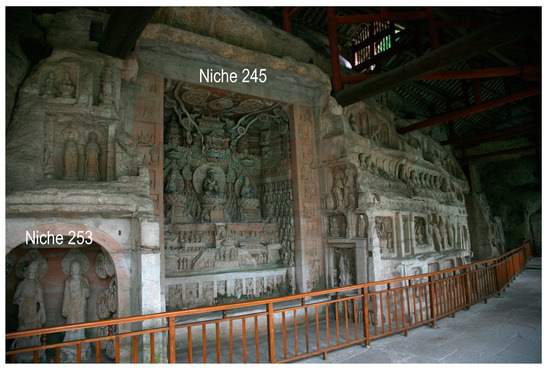
Figure 6.
Niche 245 and Surrounding Niches (photo taken by author).
In short, the two separate groups of public niches represent two orientations during Fowan’s Late Tang tenure as a military town. One group of sculptures was made by the military leadership with content suitable for bolstering military confidence and identity—a space for belief related to the military fortress itself. The second group was sculpted by wealthy laypeople and intended to address the ultimate question of the afterlife. In the Amitāyurdhyāna Sūtra’s conception, by practicing the sixteen kinds of visualizations illustrated on either side of the niches, people could ensure rebirth in the Pure Land (Jones 2019). More importantly, such a large, group-financed niche, itself much like a non-religious commemorative stele, hailed the beginning of more than six decades of statue-making activities in Fowan, in particular, the pre- and post-Shu periods (902–965), when 91 new niches were added around Niche 245 alone, a number far exceeding the three new niches added during the Late Tang, almost filling out the entire face of the cliff between Niche 190 and Niche 285. Almost all niches were family-funded and constructed, meaning we can regard them as a kind of family religious space. Given the characteristics of cliff sculptures, it would prove nearly impossible to transform old niches into new ones, unlike the transformation of the lower, earlier caves at Mogao into the large family caves from the Five Dynasties period. The ratio of currently visible niches from the Late Tang Dynasty against pre-Shu and post-Shu niches largely reflects this difference in the degree of layperson use of the cliff face. Clearly, once Wei’s secessionist regime disintegrates and we arrive in the pre- and post-Shu periods, the cliff space was considerably liberated. In 14 surviving sculpture records carrying donor information, we find four military officers, two government officials, six civilians, one monk, and one nun for this Late Tang through Five Dynasties period, with women and one military figure among the civilians. Niche size shows a general positive correlation with donor rank, reflecting his or her economic power.
The popular subject matter on Five Dynasties merit shrines at Fowan included the Amitābha Buddha, Avalokiteśvara, Kṣitigarbha (Hida 2007), Bhaiśajyaguru (Medicine Buddha), Cintāmaṇicakra, and Uṣṇīṣa Vijaya Dhāraṇī Sūtra (Liu 2008). These themes are not drastically different from contemporary Buddhist imagery on silk scrolls uncovered at the Dunhuang caves (Gies 1995–1996). Given the chance to systematically examine the niches from the Five Dynasties at Fowan, it becomes apparent that the overwhelming majority lack distinctiveness, constituting mere repetitions or combinations of the aforementioned themes. What constitutes a degree of local flavor is the variety of groups and matching statuary depending on the needs of the devotee. Niches 279 and 281 feature rich construction records and boast a unique assemblage, which makes them a rare individual case study (Figure 7). Niche 281 was completed in 954, followed by Niche 279 the following year—placing construction a mere decade after the Northern Song conquest of Later Shu. The shrines are thematically more-or-less identical. In Niche 281 we find a Medicine Buddha with attendants, the Seven Past Buddhas, the Trikaya Buddhas, the Amitābha Buddha, the Uṣṇīṣa Vijaya Dhāraṇī Sūtra Pillar, and three Kṣitigarbha sculptures. Niche 279 features all of these, apart from the Medicine Buddha (though a dedication invokes “reciting a copy of the Medicine Buddha Sutra”) and the Trikala Buddhas, and contains only a single Kstigarbha. Yao Chongxin, discussing these two niche assemblages, makes the point that similar designs were unprecedented in sutras, instead designed as a comprehensive solution for the donor aiming to satisfy the hopes and prayers of family members and the deceased in life and the afterlife. Specifically, the function of Amitābha was to guide the deceased to the Pure Land of the West, the Medicine Buddha to satisfy secular aspiration as well as guide the deceased, and the Uṣṇīṣa Vijaya Dhāraṇī Sūtra and Kṣitigarbha to guard the newly deceased from making the descent into hell. The above themes and niche vows for “a pure and contented body, long and prosperous life, peace for family and dependents, high rank and emolument, for progeny to share in the same fortune,” largely match. Put simply, the combination was a double-insurance policy good for both life and the afterlife (Yao 2013). The donors at niche 281 belonged to the family Liu Gong刘恭. He, “bailiff at the city, presiding over Yamen affairs” 都押衙、知衙務, in the confidence of the highest officials at Chang Prefecture, could also enjoy a well-off family, with two wives and three children. Niche 279 was used for offerings by the family of Wang Chengxiu 王承秀, tongyinguan 通引官, a yamen runner subordinate to Liu Gong. The two niches are situated adjacent to each other, suggesting a good personal relationship between the two officials and that craftsmen were hired from the same workshop. Later Shu was one of the less war-stricken of the Five Dynasties, yet the multiple Kṣitigarbhas sculpted at each niche reflect a fear of uncertainty against the prevailing zeitgeist.
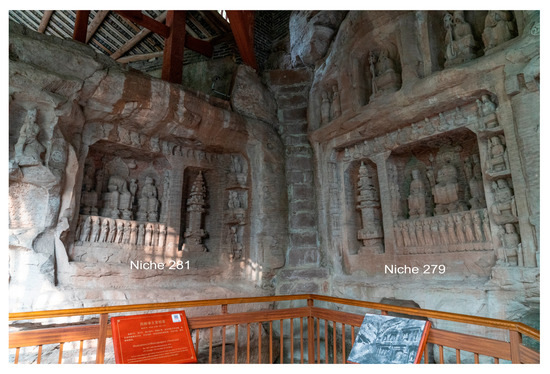
Figure 7.
The Liu Gong Family Shrine, Niche 281, and the Wang Chengxiu Family Shrine, Niche 279 (photo taken by author).
In short, Niche 245 was originally a public niche funded by commoners. This pattern of group-funding, whereby a crowd of offerants was depicted in the lower register of the statue, had already appeared in some grottoes of the Northern Dynasties grottoes as well as sculptures in urban settings. The Amitāyurdhyāna Sūtra in this niche, though, catered to a universal desire of the common people to enter the Western Pure Land after death, and subsequent Five Dynasties donors saw the huge niche as a public monument, which they would consciously augment by way of flanking sculptures—these carvings slowly emerging as a visual center. By contrast, with the founding of the Former and Later Shu polities, Longgang fortress fell apart as a military space, that first group of publicly funded and carved niches serving Longgang neither visually corresponded to nor otherwise connected with later statuary of the Five Dynasties.
3. Prayers for the Deceased and Buddhist Lay Feasts
It is possible that the unusually crowded rock face of Niche 245 can be ascribed to the completion of sculpting only at the termination of the Five Dynasties. Judging from those niches with a chronological date, the opening of new niches at Fowan essentially came to a halt for a period of over a century from 960–1077. The sole activity seems to have been some “refurbishing” of selected Five Dynasties niches by family groups in the early Northern Song. Discussions of Niche 253 suggest this in practice involved “re-using” dated niches (DSD 1999, p. 35, Plates and Explanations). Niche 253 is a small niche at 1.57 m in height and being 1.22 m wide (Figure 6). It is close neighbors with Niche 245 and contains a Guanyin, Kṣitigarbha, and Ten Kings of Hell (X. Li 2019). The surviving inscription, however, dates to the Northern Song. The inscription refers to a rebellion around the year 994. Scholars have investigated this event and believe the rebellion was connected with peasant uprisings under Wang Xiaobo 王小波and Li Shun 李順 which impacted a relatively wide swathe of territory (Deng 1995). Seven years later, Chen Shaoxun 陳紹珣, Office Manager for the Commander 都知兵馬使—the highest-ranking local position—together with his wife from the Huang clan, employed the space for the Shui-Lu Feast 水陸齋, praying for a harmonious household (DSML 1999, pp. 72–73). One can imagine the huge impact of these uprisings on the Chen family and the accompanying psychological trauma.
My question is, why would Chen choose this niche alone as a site for the Shui-Lu Rite? This can be explained from two levels—the niche through its statues and the niche as a ceremonial space. From the former perspective, Niche 253 was initially carved to accommodate the “Lay Feast for the Ten Kings of Hell十王齋” (Teiser 1994). When Chen and his family created a space for the Shui-Lu Feast, they were putting the ritual space to a fundamentally different use. The Shui-Lu Feast Ceremony emerged as late as the late Tang Dynasty and was extremely widespread by the Song Dynasty. Su Shi 蘇軾, a great Northern Song literatus, used this ritual to mourn his late wife, hence the later name of the ceremony—“Meishan Shui-Lu” 眉山水陸—after Su’s hometown region. The main difference between the Ten Kings of Hell and Shui-Lu Feasts was that the former could release the dead from purgatory and “deposit” blessings for the afterlife (“pre-cultivation” 預修) through a relatively abbreviated ceremony, whilst the latter involved invocations of a great number of deities and Buddhas (including the Ten Kings) and was renowned for the complexity of the ritual. The Shui-Lu Ceremony began as an expiation ritual like the Ten Kings Ceremony but later became multifunctional, with prayers for the avoidance of disaster and general blessings. Expiation of the dead is the theme common to both and must have been a primary reason the Chens borrowed this niche space. On the other hand, we should consider the atmosphere surrounding the niche. In the area between Niches 190–285, we can distinguish as many as 22 Kṣitigarbha statues and 8 Uṣṇīṣa Vijaya Dhāraṇī Sūtra pillars. Both served to prevent the deceased from descending into hell. As stated above, these sculptures responded to the fear of warfare during the Five Dynasties. Judging from Niches 279 and 281, it was less expiation for “former spirits and distant progeny to share in the same fortune”. Yet the Uṣṇīṣa Vijaya Dhāraṇī Sūtra pillars and Kṣitigarbha statues, which densely appeared in the northern stretches of Fowan, could easily have been misread by Song contemporaries as a specialized space for preventing the deceased from descending into hell. The misunderstanding was repeated by many others outside of Chen Shaoxun.
With the full benefit of hindsight, the re-use of Niche 253 can be interpreted as a transitional act in the spatial shift from a merit shrine to a lay feasting space. While the term for “lay feasting” 修齋 appears frequently in Late Tang and Five Dynasties Buddhist inscriptions from Sichuan, the term is usually associated with the phrase “as an expression of celebration”; i.e., the “lay feasting” in this context was a simple celebratory ritual honoring the shrine’s completion, not in any way harmonized with the shrine content. Rephrased, the very act of constructing a shrine was what brought the devotee the bulk of his merit, while the lay feast was merely the concluding event. By Song times, though, the connotations of “lay feast” 齋 underwent fundamental changes. The Southern Song eminent monk Zhipan’s edited Comprehensive Records of Buddhist Ancestors 佛祖統紀—a renowned complete history of Buddhism—provided summaries of more than ten individual lay feasting or dedicatory events, among them including Offerings for the Arhats 羅漢供, Lay feasting on the Death Anniversary of Śākyamuni 佛祖忌齋, Three Extended Fasts 三長齋, Lay feasting in Premortem Rituals 預修齋, Dedications to the Twenty-Four Protective Heavenly Deities 供天, Ghost Festival Dedications 盂蘭盆供, Shui-Lu Ceremony Lay Feasting, Food for Hungry Ghosts 六道斛, and Dedications to the Ten Kings of Hell 十王供 (Takakusu and Watanabe 1924–1936, T.49:319a–322a)—a display of the variety and complexity of Song lay feasting ceremonies.
Fowan’s Song niches adjusted their form to meet this new trend. Between Nos. 105 and 123, we find 14 medium-sized Song niches of similar form (Figure 8). Compared with Late Tang Five Dynasties niches, these exhibit the following shared features: (1) a significant increase in niche depth, with statues laid out on the front, left, and right walls, with the niche base subsequently forming a platform large enough to place offerings; (2) niches constructed at approximately the same height, appropriate for worshipers to make offerings directly facing the niche. Such rules for variation niche structure are applicable to most other Song niches in Sichuan (Hu and Chen 1986). In addition, 6 of 14 niches contain traces of an inscription tablet 匾額 in a square- or fan-shape. These inscriptions may have conveyed information about the family or lineage behind the niche. This implies that the use of niches by such groups was periodical: Family or lineage members would frequent niches for lay feasting or rituals during specific festivals. Precious visual records of such a scene and related shifts in niche form are depicted in Zhou Jichang’s 周季常 Pictures of the Five-Hundred Arhats (Figure 9), dating to the Southern Song. Seen up close, a monk leads a family through the ritual of lay feasting and offering. The group faces an offerings table on which an incense burner and vase have been arranged. In the upper-right, from a long perspective, a small group of handymen busy themselves arranging lay feasting rice on a table for offerings placed in front of an Arhat statue in hanging-scroll format (Bloom 2016). Both types of offerings—flowers and the lay feasting rice—were appropriate at different parts of the ceremony. My supposition is that in order to facilitate the placement and substitution of offerings and to accommodate the increasingly routinized lay feasting ritual, Song craftsmen based in Sichuan designed a new type of niche for the wealthier families or lineages, which involved eliminating the non-portable wooden offerings table and altar. As this new niche form spread, all forms of Buddhist niches were transformed regardless of any actual use for lay feasting ceremonies. To better understand the traits of different niche forms through time at Fowan, I refer to the smaller, shallow niches from the Late Tang and Five Dynasties as “merit niches” and the new, deeper niches of the Song Dynasty as “feast shrines”, reflecting the historical transition from statue-centered to lay feasting-oriented niches, and the newer, deeper-bayed Song niche as a “lay feasting niche”. This embodies the historical transformation from sculpture-centric niches towards those oriented towards lay feasting ceremonies. The line separating these two, however, was never absolute.
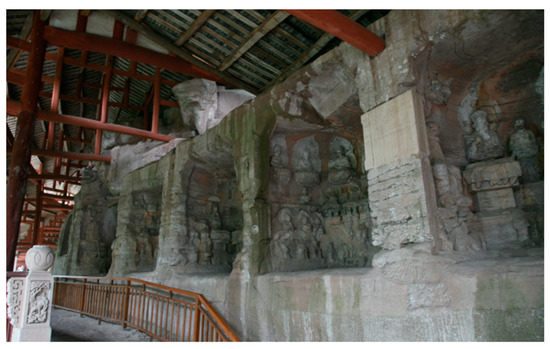
Figure 8.
Niches 106–112, Song Dynasty (photo taken by author).
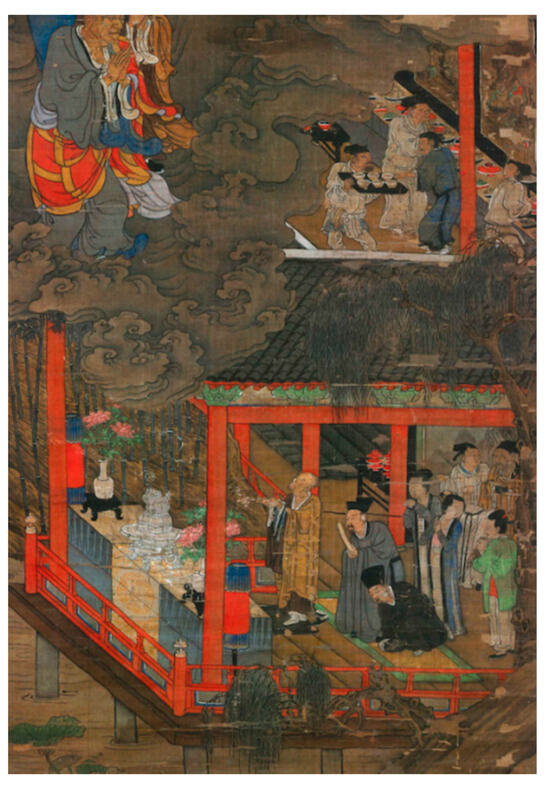
Figure 9.
Scene of “Presenting Offerings for Arahats” from Pictures of the Five Hundred Arahats at the Temple of Daitoku-ji. Drawn by Zhou Jichang circa. 1178–1188.
Ultimately only a minimal number of merit shrines could bear the burden of providing for family fasts and dedications; these belonged to the local elites. Construction inscriptions inform us that such niches were usually put together by officials and wealthy households from Dazu, as well as local worthies and landlords from beyond the city walls. Meanwhile, others continued to put up small-scale family merit shrines or group-financed larger shrines, all in the former style. Group-financed shrines of the Song period had their own profound and persevering attributes. Niche 168, built between 1121–1122, is 7.1 m deep, 3.3 m high, and 3.14 m wide, giving it a capacious interior that merits the term “grotto”. Carvings of the Five Hundred Arhats fill the interior walls and provide an obvious purpose for construction—the “Dedication to the Five Hundred Arhats” theme. This lay feasting event originated in Tiantai, Zhejiang, during the Northern Song, spreading out across all of China. The lay feast accommodated readings for the deceased and the distribution of alms to hungry ghosts (Liu 2015). The survival of the statue inscriptions suggests that at least five families were involved in the collection of funds for Cave 168. Because of their different places of residence, it is highly likely that one monk took the lead in collecting funds.
Aside from the increase in depth when compared to the crowd-funded niches of the Late Tang, Song niches featured fewer donor statues, with the donor instead adopting a particular sculpture as a display of merit. Cave 180, built between 1116 and 1122, features a centrally placed Guanyin statue, accompanied by 12 Bodhisattvas, 3 of which bear inscriptions in the space above the crown. These inscriptions indicate the respective contribution to each statue by the main donor. Cave 136 was built in 1142 through similar fundraising, with the craftsmen creatively carving a rotating sutra-cabinet 轉輪藏 in imitation of the regular wooden kind (Yu 2020). Those turning or circumambulating the cabinet acquired the same merit as when reciting sutras.
Among the five large group-funded Niches 180, 177, and 176 and Caves 155 and 168, similar in size (2–4 m wide, see Figure 3 and Figure 4) and situated nearby, we see a noteworthy chronological feature: Most were completed within the short span of a decade, from 1116 to 1126, with three finished in 1126 alone. Inscriptions indicate these three niches came from the workshop of Fu Yuanjun 伏元俊. The craftsmen behind Cave 168 likewise hailed from the Fu Yuanjun workshop. Interestingly, each of the five niches contains a different subject matter. The Guanyin in Niche 180 is primarily responsible for relief from suffering; the primary statue in Niche 177, the “Great Sage of Sizhou” Sengjia 僧伽 (628–710), a guide to the Pure Land; Niche 176 depicts the Transformations of the Maitreya-vyākaraṇa, reflecting Maitreyan Pure Land beliefs popular in the Northern Song; Cave 155′s Mahāmāyūrī functions as a defender of the state. The fact that these themes overlap is not accidental and was most likely part of the overall planning by the Sangha community responsible for fundraising. This overall planning likely included the construction of Cave 136, dating as late as the Southern Song Dynasty. Supporting evidence can be found in the inscription at Cave 137, dated 1134. Here, the “monk Zhicheng, residing in the cliff 住岩僧志誠” mentioned in the inscription (DSML 1999, p. 30) was likely some kind of administrator at early Southern Song Fowan. We can further hypothesize that despite individual statues in these niches being claimed by individual devotees, as a whole, these niches were public. The presiding officer grouped the niches together, each with their different subjects into groups that satisfied multiple claims of the faithful at Fowan. For the wider community who lacked the financial means to build niches, worshipping here fulfilled a need to pray to Buddha and other Buddhist deities. If designers and fund-raisers were resident in a nearby temple, this temple played a leading role in the construction and management of Fowan from the Northern Song to the early Southern Song.
4. A Latent Ground for Discourse
Shi Cangyong 石藏用, Major General of the Right Royal Guard in the final years of the Tang, commented with regards to Sichuan: “Great changes are due to take place across the Empire, yet Shu 蜀will be the safest sanctuary (Tuotuo 1971, p. 9929)”. It was a prophecy that repeatedly rang true. The Song History’s “Treatise on Food and Money” recorded “Campaign south on the Man 蠻 and Liao 獠, aid for You 幽 and Yan 燕 in the north, daily riots in border matters at Shaanxi and northern Sichuan, bandits and robbers rose up without warning. Income from the annual land taxes was limited… most rich people in Shanxi abandoned their property and headed to Sichuan (Tuotuo 1971, p. 4362)”. Following the Jingkang Incident, Jin troops occupied the Central Plains. Refugee soldiers from Shaanxi, Gansu, and Henan flooded the Sichuan region, and the government temporarily established checkpoints at Dasan Pass 大散關 in southwest Baoji to stem the flow of routed soldiers and the destitute. Renewed massive flows of commoners entered Sichuan in 1140. Li Shiping estimates the total number of immigrants to Sichuan in the early Southern Song at around 2.38 million people (S. Li 1987, pp. 107–29).
Although Fowan operated as a religious site during the Song and lay far from the Song–Jin frontline, war and migration still exerted a marked impact on the site. An inscription on a large group-funded niche built from 1142–1146 in the Southern Song Dynasty appears to read “Mason Xu An 胥安, Engraver from Yingchuan 潁川,” i.e., present-day Yuzhou, Henan. An, stonemason from north China, would have arrived with waves of immigrants. The majority of these refugees, as new arrivals in Shu, had less of a firm foothold and lacked the financial resources to have sculptures carved at Beishan—surviving inscriptions reveal hardly a trace of northern immigrants. A more notable impact is seen in the “modification” of tantric fashions and iconography in the choice of subject matter. Chen Yunü places the Mārīcī of Niche 130 (Figure 10) in the historical context of the Song—Jin conflicts of the early Southern Song (Y. Chen 2007). This Mārīcī is a three-faced tantric goddess who wields weapons in her eight arms. She rides a chariot pulled by boars. The Tang Dynasty monk Bukong 不空, a member of the tantric school who traveled to China from India in his translated Sutra of Thus Spoke the Buddha on Mārīcī 佛說摩利支天經 mentioned that the deity’s ability to protect believers from disasters including perils during travel, travails when lost, fires, and floods, noting the particular veneration for protection from warfare. In a new translation by the early Northern Song Dynasty Indian monk Devaśāntika 天息災, Mārīcī explicitly mentioned resisting the predations of neighboring countries (Takakusu and Watanabe 1924–1936, T.21:264c–266a). Tom Suchan notes that the difference between the Beishan Mārīcī and classic iconography lies in the eight additional multi-armed guardian deities bearing their own weapons who flank the goddess. This only increased Mārīcī’s strength as a goddess of war. Suchan even speculates that the niche might have been sponsored by local officials—an idol to boost public morale during wartime (Suchan 2003, pp. 319–25). A similar situation seems to have occurred in the immediately adjacent Niche 133. The primary object of worship, a Water–Moon Guanyin, was originally a novel style pioneered by the Late Tang artist Zhou Fang 周昉. The ingenuity of the original design lay in exploiting Guanyin’s reflection in the water as a metaphor for Buddhist emptiness, integrating Buddhist teachings into painting. Here, however, four heavily and multiply armed Divine Generals flank the Guanyin. Through changing these accompanying sculptures, the designer behind this niche increased spatial functionality to include alleviation from the suffering of war. The meaning of the primary statue shifted accordingly.
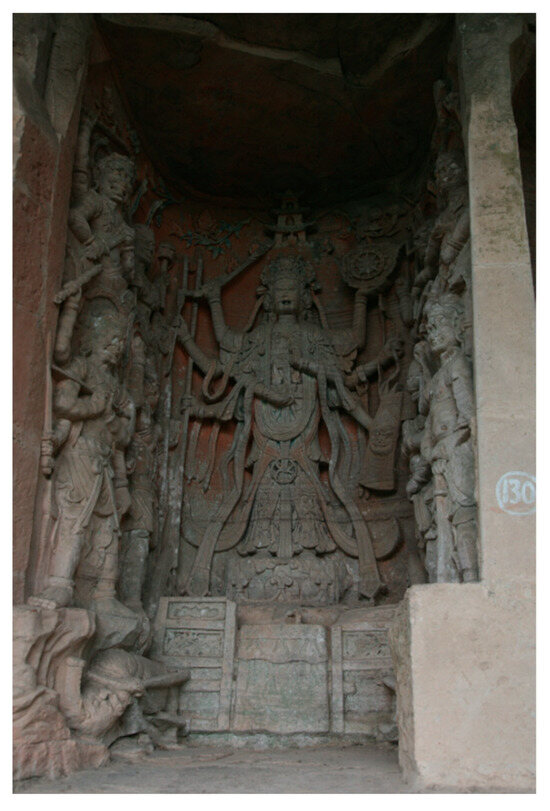
Figure 10.
Mārīcī at Niche 130, probably early Southern Song (photo taken by author).
The idea behind the design of the statues in Caves 155 and 149, in contrast, derives more from the perspective of national identity. Cave 155 is 6.07 m deep and 3.22 m wide, with a primary Mahāmāyūrī deity located in the center of the cave floor (Figure 11). The layout is similar to the Central Pillar Caves popular in the Northern Dynasties, which permitted circumambulation of the main deity by worshippers. The Mahāmāyūrī is presented in female, non-wrathful manifestation. Despite none of the six surviving versions of the Mahāmāyūrī Sutra explicitly making reference to the deity as a “state protector”, Mahāmāyūrī was worshipped as a savior and defender of the nation (Jien 2010, pp. 207–11). The Fowan Mahāmāyūrī was completed in the first year of the Jingkang reign period (1126) by Fu Yuanjun and his son, Fu Shineng 伏世能, who belonged to a local generational family of carvers. This was one year before the fall of the Northern Song with the full-scale attack on the Song by the Jin and the conquest of Kaifeng. The population of Dazu was greatly disturbed by this rapid turn of events in the north. In all, we have six surviving Mahāmāyūrī statues at Dazu and Anyue, which date to the end of the Northern Song through th Southern Song (Suchan 2003, pp. 343–53). The historical background provided by the fall of the Northern Song and Southern Song–Jin war aptly explains the motivation behind these statues.
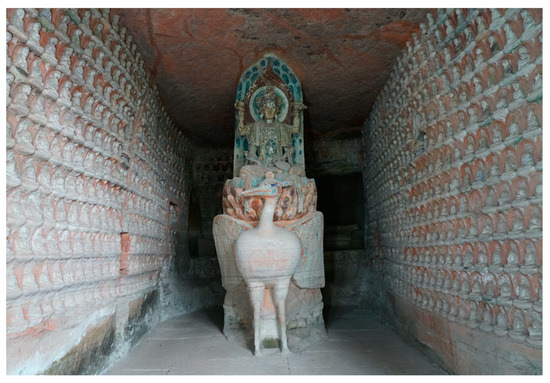
Figure 11.
Cave 155, Mahāmāyūrī surrounded by thousand Buddas, 1126 (photo taken by author).
Cave 149 (Figure 12), immediately adjacent, was built in the second year of the Southern Song Dynasty (1128). At 3.43 m high, 3.22 m wide, and 3.46 m deep, it is the largest cave in Fowan to have been funded by a single family. Cave size is generally a visual reflection of the financial power or social status of the devotee. Not surprisingly, the devotees in this case were Ren Zongyi 任宗易, the highest-ranking military and civil official in Changzhou, and his wife, Du Huixiu 杜慧修. The inscription mentions the primary statue, Cintāmaņicakra (a tantric variant of Guanyin) but does not mention the 41 guardian deities on either side of the statue, generally taken to be “Dharma Protectors”. These were protector deities Buddhism had integrated from Brahmanism and Indian folk beliefs. However, only two of these deities retain the multiple-arm, multi-headed form of the original Indian god. The remainder have essentially been “Sinified” as Song dynasty civil officials or generals. Whether or not these are intended to be dharmapāla, their weapons and three-row formation have the sense of a military division. The renowned historian of Chinese science, Joseph Needham, even argued that two generals in Cave 149 can be seen holding a “bombard or a handgun”, newly invented and used in the Song military (Lu et al. 1988).
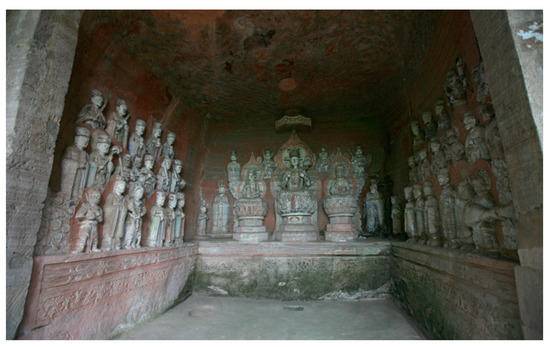
Figure 12.
Cave 149, a Cintāmaņicakra and Dharma Protectors, 1128 (photo taken by author).
Ren Zongyi had constructed this niche in the hope that it would be “forever admired and used for prayer by its devotees…… that warfare would forever come to an end (DSML 1999, p. 27)”. Its numerous martial deities seem strikingly designed as part of the prayer for this end to arms. From the very limited historical information available, we know roughly that Ren Zongyi was born in Tang’an (Chongzhou, Sichuan), that he served as an official at the end of the Northern Song and initial Southern Song, that he paid significant attention to the city’s defenses, (Xu 1957, p. 1926), and that he was a capable communicator and writer who enjoyed a good rapport with Huang Tingjian 黃庭堅, a major contemporary literatus and calligrapher (Huang 2011, p. 1011). Though a privately funded shrine, the dedicatory text and sculpture content suggest Cave 149 was built to benefit the local population, perhaps even the state, and could have guided popular sentiment as well.
Dazu’s elites, living in the violent tumult of the Five Dynasties, were compelled to pin their hopes on niches equipped with the complete array of spirits and Buddhist deities in their search for self-preservation or at the very least to soothe their anxieties. In comparison, during more than 160 years of the Northern Song rule, Dazu’s population increasingly settled down and pursued their own trades, not desiring in the least that the northern Jin would disrupt the prevailing national order. Local Dazu elites, presided over by officials, even more fervently wished to assist national heroes of the Yue Fei 岳飛 type in reclaiming lost territories in the north and pacifying the conflict, a wish they expressed through “offering strength” in religious ceremonies. Transformations in the themes at certain large shrine sculptures from the late Northern Song to the early Southern Song reflect this more proactive attitude in response to external change. The selection of subject matter for sculptures in some large shrines in this period reveals a strong sense of national identity and comes across as somewhat close to political propaganda.
As mentioned above, the large shrines built through the fundraising efforts of clergy administrators at Fowan were public in nature. These shrines allowed the general public, unable to afford their family shrines, to utilize public shrines for Buddhist rituals ranging from worship to prayers to offerings for the deceased. These large-scale gatherings probably brought people together, particularly so during certain special festivals such as the Ghost Festival (Teiser 1988), at which time residents of Chang Prefecture would spontaneously gather at Fowan. We can imagine how the sangha may have acted as ritual leaders, elucidating the function of the objects of worship, for example, the protective functions of the Mahāmāyūrī and dharmapāla. Attendees, similarly, might express or discuss their views on current affairs. In this way, a Buddhist space permitted the minutiae of exchange of political viewpoints among monks, officials, local elites, and common people. Buddhist activities may have been the primary focus of Fowan, but this complex space, in spite of itself, emerged as a public venue for debate. Certainly, relying on the existing remnants and inscriptions, we cannot definitively confirm the occurrence of the mentioned activities in history. After all, we cannot comprehensively infer all social activities that may have taken place in this venue based solely on material evidence. Nevertheless, I am prepared to present the aforementioned speculations for readers to contemplate.
The final examples discussed in this paper are Stele 103 and 104 (Figure 13), generally considered products of the Xiaozong reign period (1187–1194) of the Southern Song. These niches are not Buddhist statues but materializations of Confucian ideological texts. Specifically, Stele 103 is a giant rock inscribed with a copy of the Ancient Text Edition of The Classic of Filial Piety. In the heart of the large niche, a gable end was excavated, into which was embedded the tombstone of the famous Northern Song courtier Zhao Zhan 趙瞻, i.e., Stele 104. The nested pair makes an interesting visual combination. In its content, Stele 103 is a classic exposition of the core Confucian concept of filial piety. The latter is an official stele that concurrently communicates a symbolic meaning of filial piety. Based on this intertextuality of visual form and content, I believe the pair should be treated as a single monument with an overarching design.
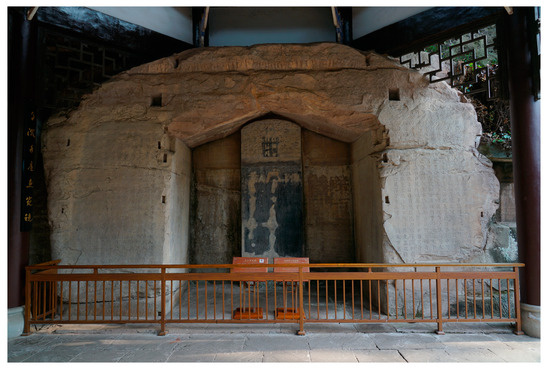
Figure 13.
Stele 103, 104, showing the Zhao Zhan stone tablet and Ancient Text Edition of The Classic of Filial Piety Stele (photo taken by author).
In the old research paradigm, scholars from a variety of disciplines have approached the pair in different ways. Epigraphers have been endlessly excited by the discovery of the long-lost Ancient Text Edition of The Classic of Filial Piety, whilst Buddhist archaeologists and art historians have almost totally ignored the two stele (Ma 1996). In my view, the presence of a Confucian in a large Buddhist space is both highly abrupt as well as puzzling. The section that follows attempts to address the purpose and mindset of the donor behind the monument.
Existing research has drawn out basic details pertaining to the stele. Commemorated is the renowned Northern Song official Zhao Zhan (1019–1090). The inscription was composed by Zhao’s contemporary, the historian Fan Zuyu 範祖禹, and the calligraphy was written by Cai Jing 蔡京 (1047–1126), known as one of the four preeminent calligraphers of the Song. The stone stele and epitaph bear a high degree of similarity, both depicting the tomb occupant’s achievements in gushing terms and both ultimately written on stone (Zhang 2020, pp. 121–23). The major difference is that the former looms large over the floor surface of the Spirit Path allowing it to be read upon entering the cemetery (Figure 14), while the latter was intended to be locked away in a stone casket in perpetuity and more symbolizes a kind of personnel file for the deceased. There would have been no greater honor for Zhao Zhan’s son than inviting Fan and Cai (the latter’s reputation intact at that time) to cooperate on the stele. Such a group of celebrities would embellish his father’s life history while lending a hand in elevating the younger Zhao’s reputation as a filial son. The problem was, however, that the initial stele reproduction was erected in distant Shaanxi—at the Zhao clan graveyards in Zhouzhi county rather than Dazu, which placed the stele in its proper home. Only in the Ming would someone peruse the original stele in Zhouzhi. The Qing scholar Zhang Shu recorded that the original donor of the Beishan stele had been Zhao Fan 趙範. In the twentieth century, Chen Xishan deduced that Zhao Fan belonged to Zhao Zhan’s great-grandchildren’s generation. Zhao had ordered the stele re-carved in ancestral remembrance (X. Chen 1985, p. 213).
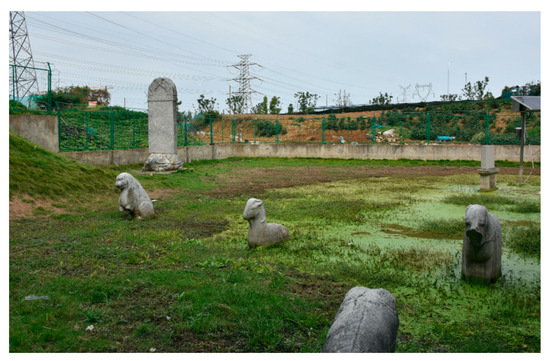
Figure 14.
Burial Ground of Wang De 王德, Renowned General during the Southern Song War of Resistance against the Jin. Erected in 1155, situated in the northern districts of Nanjing, the stele, earth mound, and stone carvings together form a cemetery landscape (photo taken by Tang Dahua).
Chen’s reasoning merely explains the motivation behind the stele and fails to address the simultaneous incising of the Ancient Text Edition of The Classic of Filial Piety. We instead need to consider the raison d’être of this combined monument in the overall Fowan context. As we saw in the previous discussion, one primary function of Song Dynasty Fowan lay in ensuring expiation for the dead. Both rich and poor households arrived here to organize memorial services through either public or exclusive family niches. One social phenomenon that ran parallel to Buddhist rituals was cremation. People of Song times opted for cremation out of a variety of complex reasons, including Buddhist beliefs, economics, and the consequences of immigration (Ebrey 1990, pp. 406–28; Kuhn 2014, pp. 456–61). To staunch Song Confucian scholars, however, cremation constituted an unfilial act. Confucians firmly opposed the placement of cremated ashes in ancestral graves (Zhang 2020, pp. 110–11). Among Song tombs found in Chengdu, also in Sichuan, cremated burials from the Southern Song account for about 80% of the total, a high rate of cremation rate surely related to the large numbers of refugees moving from the north, with cremation solving issues related to their demise away from ancestral homes (J. Chen 1956). The situation around Dazu was presumably the same. Given the absence of a grave and the deceased, Buddhist expiation emerged as the preferred means of paying homage to their ancestors among cremating families. The ritual, after all, served a similar purpose to tomb and ancestral rites as advocated by Confucianism (Zhu 2020), though with a different underlying religious philosophy. The vast majority of Song scholars were not, in fact, Confucian fundamentalists. The chapter “Commentaries: Memorial and Expiations” contained in the Encyclopedia of Five Hundred Written Gems from the August Song 皇宋五百家播芳大全文粹 contains numerous texts on the use of Buddhist lay feasting ceremonies by Song scholars for expiations (Wei and Ye 2008). These include the Arhat Lay Feast, Water–Land Lay Feast, and Eight Bodhisattva ritual. These contain a profusion of expiation rituals, and corresponding statues are visible at Fowan.
Revisiting the combined monument with the Ancient Text Edition of The Classic of Filial Piety and Zhao Yijian spirit way stele, both texts share the emphasis on filial piety, a core concept of Confucianism. In the view of Song Confucians, the older the ritual text, the more orthodox. This granted the Ancient Text Edition of The Classic of Filial Piety a symbolic significance in the restoration of ancient rituals. This monument emphasizing filial piety is similarly detached from the Confucian venues suitable for its placement, as in the case of Emperor Xuanzong of the Tang Dynasty, whose Imperial Annotated Shitai Filial Piety Scripture Tablet 御注石臺孝經碑 was originally placed in the capital city of Chang’an, in the State Scholarship Academy 國子監 (Figure 15). In terms of location, this combined monument was cut into a relatively free-standing boulder at the southernmost end of the northern cliff, virtually the only remaining undeveloped cliff face following the wave of niche opening since the Southern Song. When Zhao Zhan’s descendants contemplated the construction of this unusual monument, they may have ruminated upon the matter with complex and heavy emotions. On one hand, for Zhao to return to his ancestral fields in Jin in order to pay homage was impossible: He could only employ Fowan, a venue where locals held ceremonies to guide their ancestors to the Pure Land, as a site for the establishment of a Spirit Path. On the other hand, Zhao may have hoped to use the Ancient Text Edition to expostulate his own ideas on the proper performance of filial piety. While filial piety in the genuine Confucian sense was only realizable by returning to ancestral graves and worshipping before the Spirit Path, this required literally seizing back lost territories. Fowan retains a number of inscriptions by Southern Song visitors—showing the site was already an open “tourist attraction”. Scholars who grew up becoming versed in the Confucian classics Four Books visited Beishan Mountain or crowds arriving to commemorate the dead in festivals. One can wonder if they comprehended Zhao Fan’s original intention. When weighed with the “war party” and “pacifist party” in a constant trial of strength at the South Song court, such an expression of grassroots consciousness demonstrated the polarity of the Southern Song political situation.
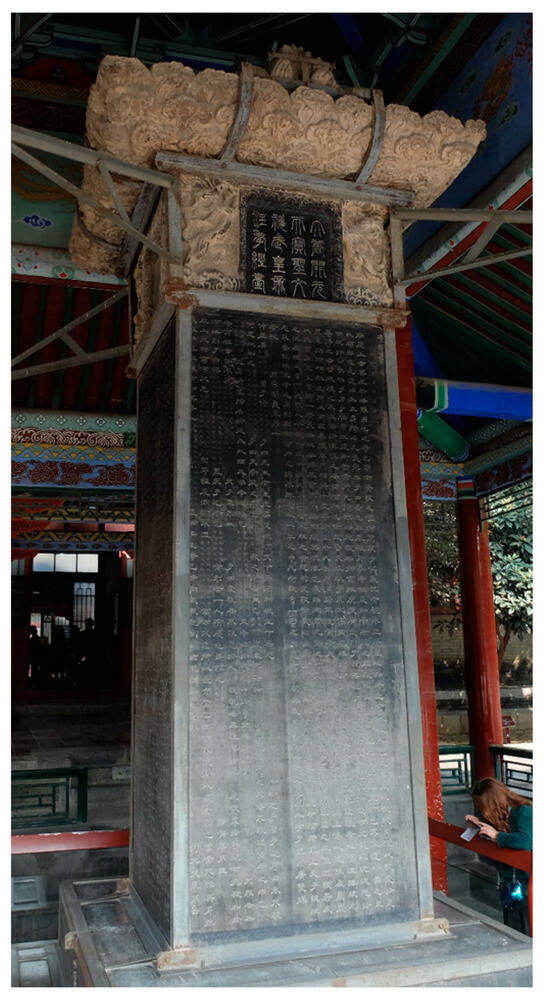
Figure 15.
Stone Platform Stele of The Classic of Filial Piety with Imperial Annotations by Emperor Xuanzong of Tang, 745. In the collections of the Xi’an Stele Forest Museum (photo taken by author).
5. Conclusions
This paper follows an overall historical narrative arc, but its goal has not been to construct a chronicle of Fowan. Instead, we have focused on a trend toward continuity across the ages. It has, for example, been difficult to establish any connection or narrative between Niche 245 from the Late Tang, Niche 281 from the Five Dynasties, Niche 177 from the Northern Song, and Stele 103 and 104 from the Southern Song if using the single niche as a unit. However, using the idea of “venue”, we find that Pure Land imagery in Niche 245 of the Amitāyurdhyāna Sūtra was “hearkened to” and rebuilt by subsequent donors. Liu Gong, the local official who built Niche 281, regarded Niche 245 as a public monument and had craftsmen add the Dhāraņī pillar to protect family members and ancestors from the descent into hell. Monk administrators at Fowan pooled their funds to build the Niche of the Three Sacred Monks (Niche 177), centered on the Great Sage of Sizhou, transforming Fowan into a site for expiation of the dead, which benefited the community at large. This tendency towards a Buddhist-theme family ritual space was further strengthened during the Southern Song when the scholar Zhao Fan aimed to inspire contemporary reflection on Confucian filial piety through his designed combined monuments (Stele 103 and 104). The concepts of Pure Land, expiation, family worship, and filial piety interacted and combined. This engendered an inherent continuity in the shifting atmosphere of this venue.
The advantages of analysis of Fowan as a venue lie in inspiring a modern sympathy for historical times. Considering the collection of Five Dynasty niches focused around Niche 245, we almost automatically sense the fear and unease in Dazu society under Late Tang and Five Dynasties disorder. When we uncover the transition from niches towards lay feasting venues, images of bustling crowds, incense, prayers, and Buddhist monks chanting sutras float across the mind. Stele 103 and 104, individual expressions whose tone differs from the overall atmosphere at Fowan, are thus also brought to the fore. Thus, from these indistinct cliff faces, we get to witness the individuals who played their part in the venue of Fowan. Ultimately, the essence of the humanities is to outline past situations.
Funding
This research received no external funding.
Institutional Review Board Statement
Not applicable.
Informed Consent Statement
Not applicable.
Data Availability Statement
Data is contained within the article.
Conflicts of Interest
The author declares no conflicts of interest.
References
- Bloom, Phillip E. 2016. Ghost in the Mists: The Visual and the Visualized in Chinese Buddhist Art, ca. 1178. The Art Bulletin 3: 297–320. [Google Scholar] [CrossRef]
- Chen, Jianzhong 陳建中. 1956. Chengdu Shijiao De Songmu 成都市郊的宋墓 [Song Tombs in Chengdu City and Surroundings]. Wenwu Kaogu Ziliao 6: 50. [Google Scholar]
- Chen, Xishan 陳習刪. 1985. Dazu Shike Zhilue 大足石刻志略 [Brief Record of the Dazu Carvings]. In Dazu Shike Yanjiu. Chengdu: Sichuan Sheng Shehui Kexueyuan Chubanshe. [Google Scholar]
- Chen, Yunü 陳玉女. 2007. Dazu Shike Beishan Molizhitian De Diaozao Shiju 大足石刻北山摩利支天女像的雕鑿時局 [The Politics of Female Mārīcī Staties at the Dazu Carvings, Beishan]. In 2005 Nian Chongqing Dazu Shike Guoji Xueshu Yantaohui Lunwenji. Beijing: Wenwu Chubanshe, pp. 23–36. [Google Scholar]
- Dazu Shike Diaosu. 1999. Quanji Beishan Shiku Juan 大足石刻雕塑全集·北山石窟卷 [Beishan Caves (vol.), Collected Sculptures from Dazu]. Edited by Chongqing Dazu Shike Yishu Bowuguan 重慶大足石刻藝術博物館編. Chonqging: Chongqing Chubanshe. [Google Scholar]
- Dazu Shike Mingwen Lu. 1999. 大足石刻銘文錄 [Carved Inscriptions from Dazu]. Edited by Chongqing Dazu Shike Yishu Bowuguan 重慶大足石刻藝術博物館 and Chongqing Shi Shehui Kexueyuan Dazu Shike Yishu Yanjiusuo 重慶市社會科學院大足石 刻藝術研究所. Chongqing: Chongqing Chubanshe. [Google Scholar]
- Deng, Zhijin 鄧之金. 1995. Dazu Shike Shi Yibu Songdai Xingxiang De Shishu 大足石刻是一部宋代形象的史書 [The Dazu Carvings–The History of the Song Dynasty in Image Form]. In Dazu Shike Yanjiu Wenxuan Sichuan Shiku Yishu Yantaohui Ji Chongqing Dazu Shike Yanjiuhui Di San Jie Nianhui Zhuanji. Chongqing: Chongqing Shi Dazu Shike Yanjiuhui, p. 187. [Google Scholar]
- Ebrey, Patricia Buckley. 1990. Cremation in Sung China. American Historical Review 95: 406–28. [Google Scholar] [CrossRef]
- Gies, Jacques. 1995–1996. Les Arts de l’Asie Centrale: La Collection Paul Pelliot du Musée National des Arts Asiatiques–Guimet. Paris: Réunion des Musées Nationaux. [Google Scholar]
- Hida, Romi 肥田路美. 2007. Guanyu Sichuan Diqu De Dizang Guanyin Binglie Xiang 關於四川地區的地藏、觀音並列像 [On Side-by-Side Kṣitigarbha and Guanyin Statues in the Sichuan Region]. In 2005 Nian Chongqing Dazu Shike Guoji Yantaohui Lunwenji. Beijing: Wenwu Chubanshe, pp. 519–39. [Google Scholar]
- Hou, Chong 侯沖. 2013. Shizhuanshan Shike Diao Zai Shitou Shang De Shuiluhua 石篆山石刻—雕在石頭上的水陸畫 [Water-Land Paintings Carved on Rock: The Shizhuan Mountain Sculptures]. In 2009 Zhongguo Chongqing Dazu Shike Guoji Xueshu Yantao Hui Lunwen Ji. Chongqing: Chongqing Chubanshe, pp. 182–98. [Google Scholar]
- Hu, Wenhe 胡文和, and Changqi Chen 陳昌其. 1986. Qiantan Anyue Yuanjuedong Moya Zaoxiang 淺談安嶽圓覺洞摩崖造像 [The Cliff Statute at the Cave of Perfect Enlightenment–A Brief Discussion]. Sichuan Wenwu 1: 23. [Google Scholar]
- Huang, Tingjian 黃庭堅. 2011. Huangtingjian Quanji Jijiao Biannian 黃庭堅全集輯校編年 [Collected Works of Huang Tingjian with Notes and Chronology]. Edited by Yongxiao Zheng 鄭永曉. Nanchang: Jiangxi Renmin Chubanshe. [Google Scholar]
- Jien, Shizuka 靜慈圓. 2010. Riben Mijiao Yu Zhongguo Wenhua 日本密教與中國文化 [Japanese Tantra and Chinese Culture]. Translated by Jianying Liu 劉建英, and Sheng Han 韓昇. Shanghai: Wenhui Chubanshe, pp. 207–11. [Google Scholar]
- Jones, Charles B. 2019. Chinese Pure Land Buddhism: Understanding a Tradition of Practice. Honolulu: University of Hawaii Press. [Google Scholar]
- Kuhn, Dieter. 2014. Religion in the light of Archaeology and Burial Practices, Modern Chinese Religion I: Song-Liao-Jin-Yuan (960–1368 AD). Edited by John Lagerwey and Pierre Marsone. Boston: Brill. [Google Scholar]
- Lei, Yuhua 雷玉華. 2011. Bazhong Shiku Yanjiu 巴中石窟研究 [Research on Central Sichuan Grottoes]. Beijing: Minzu Chubanshe, pp. 231–42. [Google Scholar]
- Li, Fangyin 黎方銀. 1999. Dazu Beishan Shiku 大足北山石窟 [The Beishan Caves, Dazu]. In Dazu Shike Diaosu Quanji Beishan Shiku Juan. Chongqing: Chonqging Chubanshe, pp. 7–15. [Google Scholar]
- Li, Fangyin 黎方銀, and Xixiang Wang 王熙祥. 1988. Dazu Beishan Fowan Shiku De Fenqi 大足北山佛灣石窟的分期 [Periodization of the Fowan Grottoes, Beishan, Dazu]. Wenwu 8: 31–45. [Google Scholar]
- Li, Jingjie 李靜傑. 2016. Dazu Baodingshan Nansong Shike Zaoxiang Zuhe Fenxi 大足寶頂山南宋石刻造像組合分析. [Analysis of the Southern Song Sculpture Groups at Baodingshan, Dazu]. In 2014 Dazu Xue Guoji Xueshu Yantao Hui Lunwen Ji. Chongqing: Chongqing Chuxanshe, pp. 1–38. [Google Scholar]
- Li, Shipping 李世平. 1987. Sichuan Renkoushi 四川人口史 [Demographic History of Sichuan]. Chengdu: Sichuan Daxue Chubanshe. [Google Scholar]
- Li, Xiaoqiang 李小強. 2019. Dazu Beishan Di 253 Kan Dizang Guanyin Kan Tanxi 大足北山第253龕地藏觀音龕探析 [Investigation and Analysis of the Kṣitigarbha and Guanyin, Cave 253, Beishan, Dazu]. Dunhuang Yanjiu 1: 62–70. [Google Scholar]
- Liu, Shufen 劉淑芬. 2008. Miezui Yu Duwang Foding Zunsheng Tuoluoni Jingchuang Zhi Yanjiu 滅罪與度亡: 佛頂尊勝陀羅尼經幢之研究 [Redemption of Sins and Expiation of the Dead: A Dtudy of the Usņīsavijayā-dhāraņī-sutra Pillar]. Shanghai: Shanghai Guji Chubanshe. [Google Scholar]
- Liu, Shufen 劉淑芬. 2015. Songdai De Luohan Xinyang Jiqi Yishi Cong Dadesi Ben Wubai Luohan Tu Shuoqi 宋代的羅漢信仰及其儀式—從大德寺宋本五百羅漢圖說起 [The Arhat Cult and Its Rituals during the Song Dynasty: With an Analysis of the “Five Hundred Arhats Paintings” at Kyoto’s Daitokuji]. Bulletin of IHP 86: 679–775. [Google Scholar]
- Lu, Gwei-Djen 魯桂珍, Joseph Needham, and Chi-Hsin Phan 潘吉星. 1988. The oldest Representaion of a Bambard. Technology and Culture 29: 594–605. [Google Scholar]
- Ma, Heng 馬衡. 1996. Song Fanzuyu Guwen Xiaojing Shike Jiaoshi 宋範祖禹《古文孝經》石刻校釋 [Exegesis of Fan Zuyu (Song Dynasty)’s Ancient Text Edition of the Classic of Filial Piety]. In Fanjiangzhai Jinshi Conggao 凡將齋金石叢稿. Beijing: Zhonghua shuju, pp. 251–59. [Google Scholar]
- Suchan, Tom. 2003. The Eternally Flourishing Stronghold: An Iconographic Study of The Buddhist Sculpture of the Fowan and Related Sites at Beishan, Dazu CA. 892–1155. Doctoral dissertation, The Ohio State University, Columbus, OH, USA; pp. 319–25. [Google Scholar]
- Takakusu, Jun-jirō 高楠順次郎, and Kaigyoku Watanabe 渡邊海旭, eds. 1924–1936. Taishō shinshū daizōkyō 大正新脩大藏經 [The Taishō Tripitaka]. Tokyo: Taishō issaikyō kankōkai. [Google Scholar]
- Teiser, Stephen F. 1988. The Ghost Festival in Medieval China. Princeton: Princeton University Press. [Google Scholar]
- Teiser, Stephen F. 1994. The Scripture on the Ten Kings and the Making of Purgatory in Medieval Chinese Buddhism. Honolulu: University of Hawaii Press. [Google Scholar]
- Tuotuo 脫脫. 1971. Song Shi 宋史 [Song History]. Beijing: Zhonghua Shuju. [Google Scholar]
- Wei, Bing 韋兵. 2020. Dazu Beisong Shousheng Xinyang Zaoxiang: Shizhuanshan Changshouwang Kan Kaobian 大足北宋壽生信仰造像:石篆山“長壽王龕”考辨. [Longevity Belief Sculptures at Northern Song Dazu: Investigating the “King of Longevity Cave” at Shizhuan Mountain]. Dazu Xuekan 4: 51–68. [Google Scholar]
- Wei, Qixian 魏齊賢, and Fen Ye 葉棻, eds. 2008. Huang Song Wubai Jia Bofang Daquan Wencui 皇宋五百家播芳大全文粹 [Encyclopedia of Five Hundred Written Gems from the August Song]. In Jing Yin Wenyuange Siku Quanshu 景印文淵閣四庫全書. Taipei: Taiwan Shangwu Yinshuguan, vol. 1353, pp. 444–56. [Google Scholar]
- Xu, Song 徐松. 1957. Song Huiyao Jigao 宋會要輯稿 [Draft of Collected Song Statutes]. Beijing: Zhonghua Shuju, p. 1926. [Google Scholar]
- Yao, Chongxin 姚崇新. 2013. Yaoshi Yu Dizang Yi Dazu Beishan Fowan Di 279 291 Hao Kan Wei Zhongxin 藥師與地藏—以大足北山佛灣第279、281號龕造像為中心 [Medicine Buddha and Kṣitigarbha—Primarily on Fowan Caves 279, 281 Beishan, Dazu]. In 2009 Nian Zhongguo Chongqing Dazu Shike Guoji Xueshu Yantaohui Lunwenji. Beijing: Wenwu Chubanshe, pp. 449–68. [Google Scholar]
- Yu, Lina 俞莉娜. 2020. Zhong Ri Zhuanlunzang Jianzhu Xingzhi De Kaoguxue Yanjiu 中日轉輪藏建築形制的考古學研究 [Archaeological Researches on Rotating Sutra Cabinet Form in China and Japan]. Zhongguo Jianshu Shilun Huikan 19: 111–38. [Google Scholar]
- Zhang, Cong Ellen. 2020. Performing Filial Piety in Northern Song China (960–1127): Family, State, and Native Place. Honolulu: University of Hawaii Press. [Google Scholar]
- Zhu, Xi 朱熹. 2020. Zhuzi Jiali Songben Huijiao 朱子家禮宋本匯校 [Collected and Annotated Zhu Xi’s Family Rituals]. Collated and Annotated by Jūji Azuma. Shanghai: Shanghai Guji Chubanshe, pp. 175–210. [Google Scholar]
Disclaimer/Publisher’s Note: The statements, opinions and data contained in all publications are solely those of the individual author(s) and contributor(s) and not of MDPI and/or the editor(s). MDPI and/or the editor(s) disclaim responsibility for any injury to people or property resulting from any ideas, methods, instructions or products referred to in the content. |
© 2023 by the author. Licensee MDPI, Basel, Switzerland. This article is an open access article distributed under the terms and conditions of the Creative Commons Attribution (CC BY) license (https://creativecommons.org/licenses/by/4.0/).